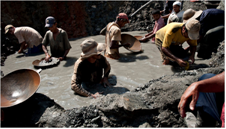The lure of profits has attracted the attention of more than just the state and multinational corporations (MNCs) to the mining industry. The FARC guerrillas and paramilitary successor groups have assumed greater roles in Colombia’s unlicensed mining sector in recent years. The police estimate that these groups “extort from or have direct control over mines in 489 out of Colombia’s 1,119 municipalities.” Armed groups engage in unlicensed mining in many different ways, making it difficult for the government to formulate a cohesive response. According to an Insight report, guerrillas in Antioquia charge a tax on mining equipment that enters their territory (3 million pesos, or $1,600) in addition to a monthly maintenance tax (1 million pesos, or $530). If miners do not comply with the guerrillas’ mandates, their equipment is destroyed. In other cases, guerrillas and paramilitaries control mine production and tax the amount of gold produced by each miner. Many analysts believe that armed actors turned to gold mining as an additional source of revenue as pressure on coca cultivation and trafficking increased.
 |
| New York Times |
In addition to security concerns, artisanal mining is also viewed as a source of environmental degradation. Colombia has the highest rate of mercury pollution in the world and other harmful chemicals like cyanide are often used in small-scale mining operations, polluting nearby bodies of water and seeping into the ground. Although the detrimental effects of artisanal mining are real and worrisome, the pollution caused by large-scale, industrial mining is far greater and more harmful. The Cerrejón mine in La Guajira, for example, has “polluted rivers, caused lung diseases, made land fallow and displaced communities.” Moreover, local campaigns have been launched to teach artisanal miners how to mine sustainably.
The Government’s Problematic Response
In response to the environmental and security threats posed by unlicensed mining operations, the government has begun shutting down mines it defines as “illegal.” In the first four months of 2011, “military and police closed 121 mines and arrested over 600 people.” Concerned with potential investors, the Santos administration has also created a prosecutor’s office for environmental crime composed of 22 attorneys specializing in environmental law. The exact legal ramifications of this office are yet to be determined but it will “reportedly prioritize investigations related to environmental contamination, invasive use of protected land, and unlicensed exploitation of resources.”
 |
| Colombia Reports |
The government claims to be cracking down on “illegal” mining in part because it is a security threat. However, Peace Brigades International points out that the “government does not differentiate between illegal mining and informal mining (mining without a license) and in fact equates informal artisanal mining with illegal mining allied with the guerrilla in order to justify the militarization of mining areas.” A report from the Consultancy on Human Rights and Displacement (CODHES) argues that the large U.S.-backed military and paramilitary presence in mining zones is intended to “protect private investment” and “suppress social protest” through violence and displacement. These actions further propagate the notion that unlicensed, artisanal mining is both dangerous and illegal. Recently, Colombia’s Mining and Energy Minister, Mauricio Cardenas, even went so far as to declare that, “police should destroy the machinery confiscated from unlicensed mines, in the same way that police destroy cocaine laboratories.” Although the government insists that its goal is to work in collaboration with local communities and small-scale miners, both its mining laws and representatives continue to discredit the people it claims to represent.
Resistance
Artisanal miners who lack legal paperwork assert that the government is trying to undermine their traditional sources of livelihood and displace them from their land so multinational corporations can operate. Additionally, unlicensed miners insist that they are being unfairly targeted by the government given the fact that, “extortion is a widespread phenomenon that also affects licensed companies and their contractors.”
 |
| Protest against mining in Cajamarca – Colombia Reports |
In response, local communities of small-scale miners are uniting in order to challenge the government’s biased support of MNCs at the expense of their land and livelihoods. Coalitions of miners, campesinos, environmentalists, social organizations and lawyers have been organizing throughout Colombia. For example, community members and miners established a Family Farmer Reserve Zone in Guamocó, a legal entity that enables “small-scale farming and mining communities to establish territorial boundaries,” support local enterprises, obtain legal land titles and protect the environment. Participants hope to replace old models of development that promote the “indiscriminate pillaging of resources” and create alternative models for sustainable, local development. In other regions, grassroots organizations are mounting educational campaigns to teach artisanal mining communities sustainable mining practices and to raise awareness nation-wide about the destructive environmental and social impacts of large-scale mining operations.
To learn more about mining and Colombia’s “gold rush,” consider watching a video from PBS and/or Al Jazeera.
Watch a music video from Afro-Colombian group, ChocQuibTown, entitled “Oro,” or “Gold."
Special thanks to Peace Brigades International for their research on this topic.





No comments:
Post a Comment